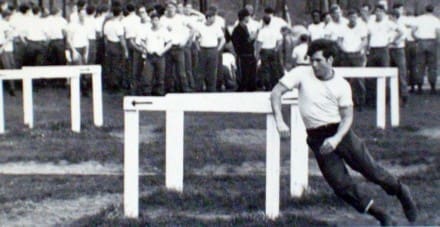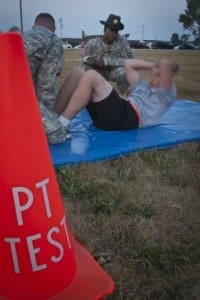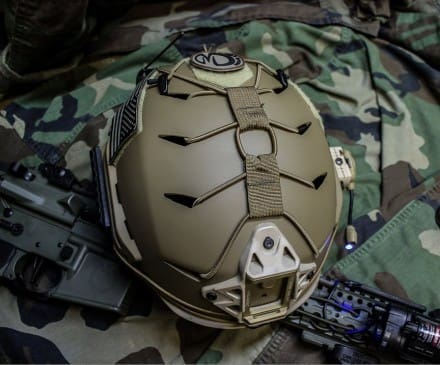
When I attended Basic Training in 1985 you could still see the physical remains of the old Army PT test (run, dodge and jump, the inverted crawl, the horizontal ladder, two mile run in boots). One of the reasons they had moved away from the previous test was that it required apparatus, like the horizontal ladder and set up for the Run Dodge & Jump event. So there would be these little sections of pits and hitching post looking things scattered around. We of course, we’re in a modern Army using a newer 3 event Army Physical Fitness Test (APFT) consisting of the Push up, Sit up and 2-mile Run. This test has remained since the early 80s with minor tweaks in expected form as well as more stringent scores.
 But over the years, the Army has made several moves to institute a test focused more on functional fitness. Every few years the idea comes up, everyone gets excited and just as soon it’s shelved. The usual reasons are that it is too expensive to implement or that it wouldn’t be “fair” across the force, particularly if different MOSs conducted different tests. This last argument holds particular concern as PT performance has been tied to promotion in one way or another.
But over the years, the Army has made several moves to institute a test focused more on functional fitness. Every few years the idea comes up, everyone gets excited and just as soon it’s shelved. The usual reasons are that it is too expensive to implement or that it wouldn’t be “fair” across the force, particularly if different MOSs conducted different tests. This last argument holds particular concern as PT performance has been tied to promotion in one way or another.
In 2011 the Army’s Training and Doctrine Command came to the epiphany “that Soldiers are better prepared if they train how they would fight.” They decided that this extended to physical fitness as well. According to an Army press release, “A five-event Army Physical Readiness Test was developed and proposed to replace the current three-event APFT. The proposed test eliminated situps and included the following: 60-yard shuttle run, one-minute rower, standing long jump, one-minute pushup and 1.5-mile run.
More than 10,000 Soldiers worldwide participated in pilot testing of the APRT. After reviewing the data, TRADOC commissioned an independent panel to validate the proposed five-event APRT.”
It looked like the Army was going to implement the switch to this new test this year. But then, a “panel of fitness experts from the Department of Physical Education at U.S. Military Academy, the U.S. Army Medical Research and Development Command, and California State University-Fullerton recommended against moving forward with the proposed five-event APRT and that TRADOC further study the issue.”
Their concern is that this new 5 event test might not properly measure Soldier fitness. Rightly so, “TRADOC has determined that baseline Soldier physical readiness would be most effectively measured if linked to Warrior Tasks and Battle Drills — tasks and drills determined over the last decade of war to be critical while conducting unified land operations.”
In October, yet another study will be conducted. In the interim, “TRADOC is preparing to reestablish the master fitness trainer program. Targeting non-commissioned officers, this program, discontinued in 2001, will eventually provide commanders at all levels certified fitness advisors. A pilot master fitness training course begins Aug. 27, 2012, to ensure that the appropriate steps are taken to restore this previously successful physical fitness asset to all units.”
Ironically, as the Army retains it’s 3-event APFT in use for 3 decades and reinstitutes the Master Fitness Trainer program, TRADOC Command Sergeant Major Daniel A Dailey has the gall to say, “It’s time to break the culture of ‘training to the test’ and focus instead on preparing all Soldiers for the physical challenges of the current and future operating environment.”
We were starting to see a trend where the military looked at its personnel as athletes and with that realization a move toward functional fitness. Hopefully, this decision by the Army to stay with the status quo is a careful step toward greatness but instead, it feels like an attempt to remain stagnant.
 NRA offers a sponsored membership program created exclusively for America’s military, law enforcement and first responder personnel. NRA Life of Duty offers exclusive content as well as a great online magazine called, “American Warrior” with sponsored features. Membership includes gear discounts, the NRA American Warrior digital magazine, as well as $27,500 in life insurance benefits for qualified NRA Life of Duty members, plus $2,500 for family travel when a loved one is wounded. Visit Join.NRALifeofDuty.tv
NRA offers a sponsored membership program created exclusively for America’s military, law enforcement and first responder personnel. NRA Life of Duty offers exclusive content as well as a great online magazine called, “American Warrior” with sponsored features. Membership includes gear discounts, the NRA American Warrior digital magazine, as well as $27,500 in life insurance benefits for qualified NRA Life of Duty members, plus $2,500 for family travel when a loved one is wounded. Visit Join.NRALifeofDuty.tv





















































































































